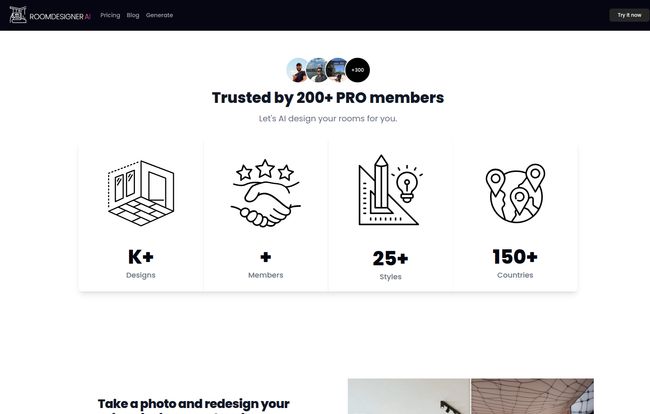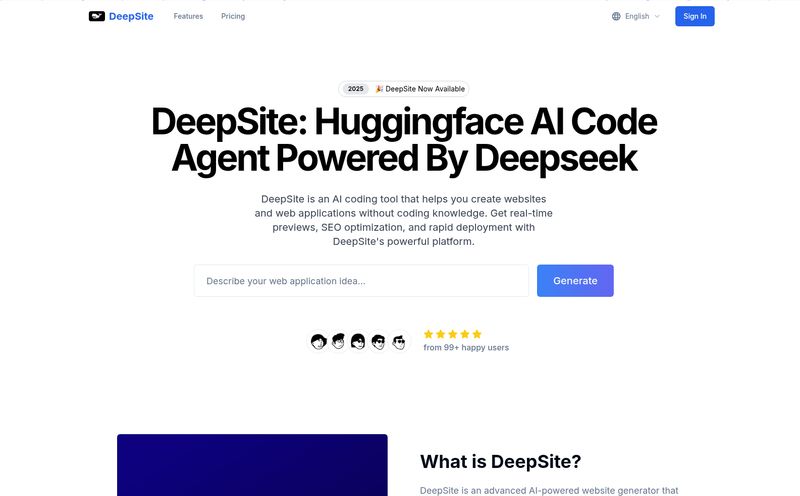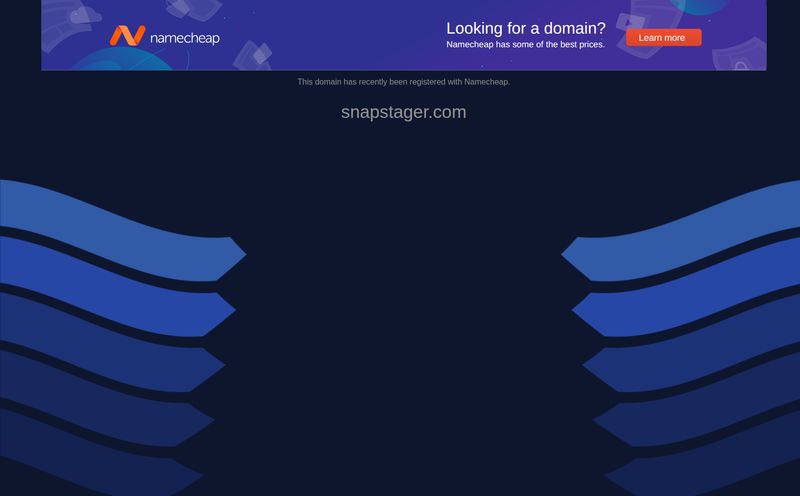Staring at an empty room is... intimidating. Whether you’re a real estate agent trying to sell a vacant property that feels a bit soulless, or a homeowner paralyzed by a beige living room, the challenge is the same. How do you make someone see the potential? For years, the answer was expensive physical staging or clunky, slow-as-molasses design software.
But there's a new player in town, and it's powered by the AI that's changing just about everything. I’ve been hearing the buzz about tools that can redesign a room from a single photo, so I had to get my hands on one of the most talked-about platforms: RoomDesigner.ai. I’ve spent the last week putting it through its paces, and frankly, the results have been pretty wild.
Is it a gimmick, or is it a genuinely useful tool for pros and DIYers alike? Let’s get into it.
So, What Exactly Is RoomDesigner.ai?
Think of it as an interior design co-pilot. RoomDesigner.ai is a web-based platform that uses artificial intelligence to transform your spaces. The core idea is brilliantly simple: you feed it an image, and it spits out a professionally designed alternative. No wrestling with complex 3D modeling software, no endless scrolling through Pinterest hoping for a miracle.
The process basically breaks down into three steps:
- Upload Your Photo: Snap a picture of the room you want to change. An empty living room, a dated kitchen, even a hand-drawn sketch on a napkin (yes, really).
- Choose Your Vibe: This is the fun part. You get to pick from over 50 different interior design styles. We’re talking everything from Modern and Industrial to niche aesthetics like Hollywood Glam and Biophilic.
- Generate the Magic: The AI takes your photo and your chosen style and generates a brand-new, fully furnished and decorated version of your room. It’s kinda like magic.
It's clearly built for a few key people: real estate agents needing fast virtual staging, interior designers looking for a rapid ideation tool, and homeowners who just want to see if a 'Coastal' theme would actually work in their land-locked suburban home.

Visit RoomDesigner.ai
My First Run: A Real-World Test
To give it a fair shake, I uploaded a photo of my own tragically uninspired home office. It’s clean, it’s functional, but it has the personality of a cardboard box. I decided to see what RoomDesigner.ai could do with it.
The interface is clean. Refreshingly so. No confusing menus or a million buttons. Just a clear 'Upload Image' prompt. I threw my office photo in and was immediately presented with the wall of styles. And wow, it’s a lot. In a good way. It’s like a candy store for design nerds.
I decided to go for something completely different from my current setup: 'Industrial'. A few seconds of processing, and... boom. My boring office was transformed. Exposed brick (virtually, of course), sleek metal furniture, Edison bulbs. It looked like a trendy downtown loft. Did it look exactly like my room's dimensions? Pretty close. The AI did a surprisingly good job of understanding the space, the windows, and the general layout. The quality was impressive—not just a blurry photoshop job, but a coherent and believable render.
The Dizzying Array of Styles
I have to spend a moment on the styles, because this is where the tool really shines. With over 50 options, you can go on a wild ride. Curious what your bedroom would look like as a 'Maximalist' explosion of color and pattern? Go for it. Want to see your kitchen in a calm, 'Japandi' style? A click away.
It’s not just the sheer number, but the variety. They have everything from the expected—Farmhouse, Scandinavian, Mid-Century Modern—to the wonderfully specific, like Tribal, Cyberpunk, and even a Halloween theme for seasonal fun. This huge library prevents your designs from looking generic. You’re not stuck with the same three AI-generated couches everyone else is using.
The Practical Uses That Actually Matter
Okay, playing design god is fun, but where does a tool like this actually provide value? This is where my SEO-brain kicks in. Who is this for, and how does it help them make more money or save time?
For the Real Estate Pro: Virtual Staging That Sells
This is the big one. Ask any top-producing agent, and they'll tell you that empty homes are hard to sell. They feel cold, and buyers struggle to gauge room size and furniture placement. According to a report from the National Association of Realtors, 82% of buyers' agents said staging a home made it easier for a buyer to visualize the property as their future home.
Physical staging costs thousands. RoomDesigner.ai lets you do it for a few bucks per photo. You can take that empty living room and generate five different versions—Modern, Traditional, Bohemian, etc.—to include in your listing. It's an absolute game-changer for making your property stand out online and helping it sell faster.
For the Designer & Architect: From Sketch to 'Wow'
The sketch-to-render feature is killer. We've all been there, trying to explain a concept to a client with a rough drawing and a bunch of disconnected sample images. This tool bridges that gap instantly. You can upload your floor plan or a simple perspective sketch, apply a style, and give your client a photorealistic render in minutes, not days. It's a powerful way to get buy-in and speed up the revision process.
For the DIY Homeowner: Curing Design Paralysis
Ever stand in a paint aisle for an hour, completely frozen? RoomDesigner.ai is the cure. It’s a low-risk sandbox to try out bold ideas without spending a dime on paint or furniture. See if that dark, moody 'Art Deco' look you've been dreaming of actually works before you commit. It’s fun, it’s inspiring, and it can save you from costly design mistakes.
Let's Talk Money: The RoomDesigner.ai Pricing Model
So, what does all this cost? This is where RoomDesigner.ai gets interesting. Instead of a monthly subscription that bleeds you dry, it uses a credit system. You buy a bundle of credits, and each image generation uses one credit. I actually prefer this model; you only pay for what you use.
Here’s the breakdown as of my writing this:
| Credits | Price | Cost Per Render |
|---|---|---|
| 30 Credits | $9 | $0.30 |
| 100 Credits | $19 | $0.19 |
| 200 Credits | $30 | $0.15 |
For a real estate agent staging a single property (say, 5 rooms, 3 styles each = 15 renders), the $9 plan is more than enough. For a designer using it regularly for client mood boards, the larger packages offer fantastic value. At $0.15 a render, the cost is almost negligible compared to the time saved.
The Good, The Bad, and The AI
No tool is perfect. After my testing, here's my honest breakdown.
What I Loved
The ease of use is number one. It's incredibly intuitive. The sheer variety of styles is a massive plus, and the quality of the renders is genuinely impressive for the speed. The pay-as-you-go credit system feels fair and respects the user.
Where It Could Improve
The output is heavily dependent on the input. A blurry, poorly lit photo will give you a wonky, less-than-ideal result. Garbage in, garbage out, as they say. Also, while the credit system is great for many, a very high-volume agency might wish for an unlimited monthly plan. And a few more free credits to start would be nice for people to really get a feel for it before buying.
So, Is RoomDesigner.ai the Real Deal?
After a week of turning my boring rooms into everything from a 'Zen' paradise to a 'Gothic' lair, I can say yeah, it's the real deal. It's not going to replace the nuanced eye of a professional interior designer for a full-scale project, but that's not its purpose.
It’s an incredibly powerful visualization tool. For real estate agents, it's a no-brainer. The ROI on virtually staging a listing for a few dollars is astronomical. For designers, it’s a brilliant sidekick for brainstorming and client presentations. And for homeowners, it’s the most fun you can have with your home decor without lifting a paintbrush.
Frequently Asked Questions
- How does the credit system work?
- You purchase a pack of credits (e.g., 30 for $9). Each time you generate one redesigned image, it costs one credit. Credits don't expire.
- Can I use the images I create for my real estate listings?
- Yes, the plans include commercial usage rights, making it perfect for MLS listings, marketing materials, and client presentations.
- What if I don't like the design the AI generates?
- You can simply try again! You can either re-run the same style (which sometimes yields a slightly different result) or pick a new style. Each new generation will cost another credit.
- How good does my original photo need to be?
- The better the photo, the better the result. Use a clear, well-lit photo taken from a good angle (like a corner of the room) for the best outcomes.
- Is RoomDesigner.ai difficult for a non-technical person to use?
- Not at all. If you can upload a photo to social media, you can use this tool. The interface is extremely straightforward and user-friendly.
My Final Verdict
RoomDesigner.ai is one of those tools that, once you use it, you wonder how you managed without it. It democratizes design, making high-quality visualization accessible to everyone. It's fast, affordable, and surprisingly powerful. Whether you're looking to sell a house faster, wow a client, or just finally figure out what to do with your spare bedroom, it's definitely worth a look. The future of staging isn't just coming—it’s already here, and it's a lot of fun to play with.
Reference and Sources
- RoomDesigner.ai Official Website
- RoomDesigner.ai Pricing Page
- National Association of Realtors® 2021 Profile of Home Staging


